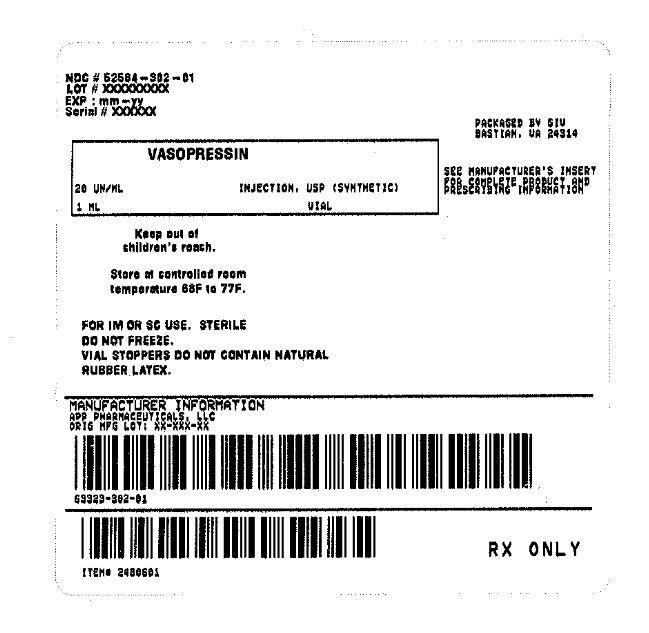Drug Catalog - Product Detail
VASOPRESSIN INJ SOL 20 UNIT/ML 1ML X 25
| NDC | Mfr | Size | Str | Form |
|---|---|---|---|---|
| 63323-0302-01 | FRESENIUS KABI USA | 1ML | 20UNIT/ML | NA |
PACKAGE FILES


Generic Name
Substance Name
Product Type
Route
Application Number
Description
DESCRIPTION: Vasopressin Injection, USP is a sterile solution of synthetic vasopressin of the posterior pituitary gland for intramuscular (IM) or subcutaneous use. It is substantially free from the oxytocic principle and is standardized to contain 20 pressor units/mL. The chemical name is Vasopressin, 8-L-arginine and has the following structural formula: Each mL contains: 20 USP Vasopressin Units, chlorobutanol (anhydrous) 5 mg as preservative; Water for Injection q.s. Glacial acetic acid and/or sodium hydroxide may have been added for pH adjustment (2.4-4.5). Formula1.jpg
How Supplied
HOW SUPPLIED: Product No. NDC No. 30201 63323-302-01 Vasopressin Injection, USP 20 units, 1 mL in a 2 mL flip-top vial in packages of 25. Store at 20° to 25°C (68° to 77°F) [see USP Controlled Room Temperature]. Do not freeze. Vial stoppers do not contain natural rubber latex. APP APP PHARMACEUTICALS, LLC Schaumburg, IL 60173 45875E Revised: March 2010
Indications & Usage
INDICATIONS AND USAGE: Vasopressin Injection, USP is indicated for prevention and treatment of postoperative abdominal distention, in abdominal roentgenography to dispel interfering gas shadows and in diabetes insipidus.
Dosage and Administration
DOSAGE AND ADMINISTRATION: Vasopressin Injection may be administered IM or subcutaneously. Ten units (0.5 mL) of Vasopressin Injection will usually elicit full physiologic response in adult patients; 5 units (0.25 mL) will be adequate in many cases. Vasopressin Injection should be given IM at three or four hour intervals as needed. The dosage should be proportionately reduced for pediatric patients. (For an additional discussion of dosage, consult the sections below.) When determining the dose of Vasopressin Injection for a given case, the following should be kept in mind: It is particularly desirable to give a dose not much larger than is just sufficient to elicit the desired physiologic response. Excessive doses may cause undesirable side effects-blanching of the skin, abdominal cramps, nausea-which, though not serious, may be alarming to the patient. Spontaneous recovery from such side effects occurs in a few minutes. It has been found that one or two glasses of water given at the time Vasopressin Injection is administered reduces such symptoms. Abdominal Distention In the average postoperative adult patient, give 5 units (0.25 mL) initially, increase to 10 units (0.5 mL) at subsequent injections if necessary. It is recommended that Vasopressin Injection be given IM and that injections be repeated at three or four hour intervals as required. Dosage to be reduced proportionately for pediatric patients. Vasopressin Injection used in this manner will frequently prevent, or relieve, postoperative distention. These recommendations apply also to distention complicating pneumonia or other acute toxemias. Abdominal Roentgenography For the average case, two injections of 10 units (0.5 mL) each are suggested. These should be given two hours and one-half hour, respectively, before films are exposed. Many roentgenologists advise giving an enema prior to the first dose of Vasopressin Injection. Diabetes Insipidus Vasopressin Injection may be given by injection or administered intranasally on cotton pledgets, by nasal spray, or by dropper. The dose by injection is 5 to 10 units (0.25 to 0.5 mL) repeated two or three times daily as needed. When Vasopressin Injection is administered intranasally by spray or on pledgets, the dosage and interval between treatments must be determined for each patient. Parenteral drug products should be inspected visually for paticulate matter and discoloration prior to administration, whenever solution and container permit.
